The Samsung Galaxy Note7 (S820) Review
by Joshua Ho on August 16, 2016 9:00 AM ESTSystem Performance Cont'd
Now that we've covered more general purpose benchmarks that tend to emphasize CPU performance and GPU compute performance, we can look at benchmarks that tend to more strongly emphasize things that games will see benefits from such as improved GPU graphics performance and improved CPU physics processing performance.
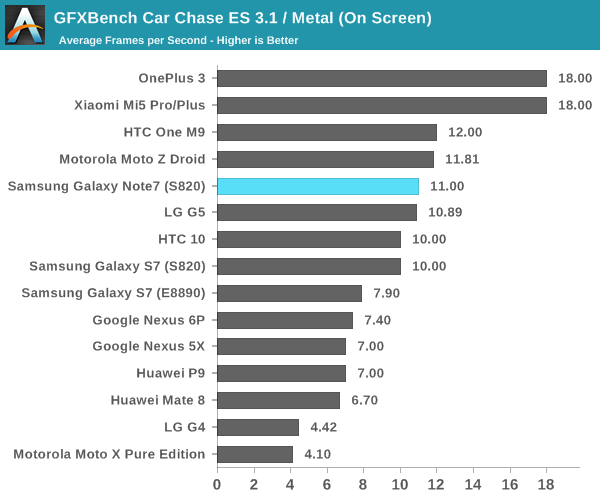
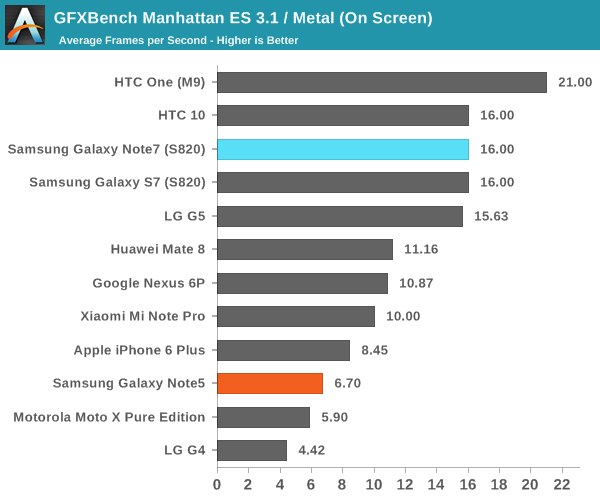
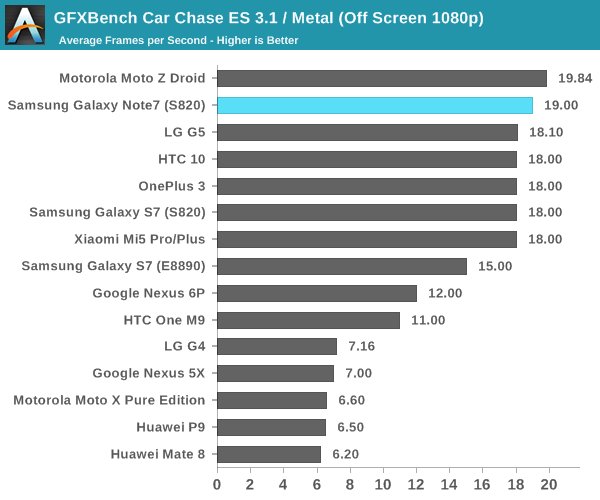
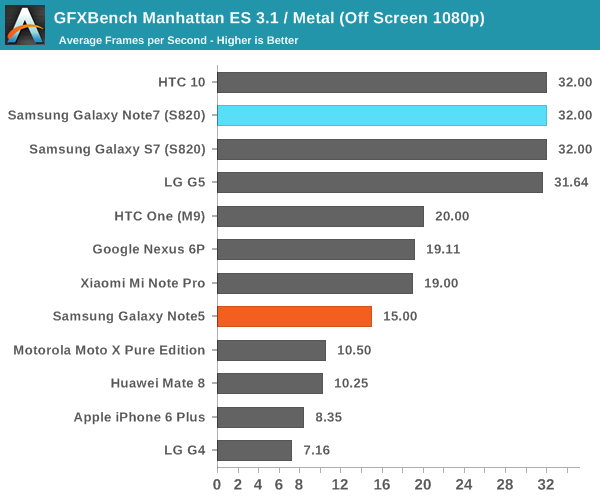

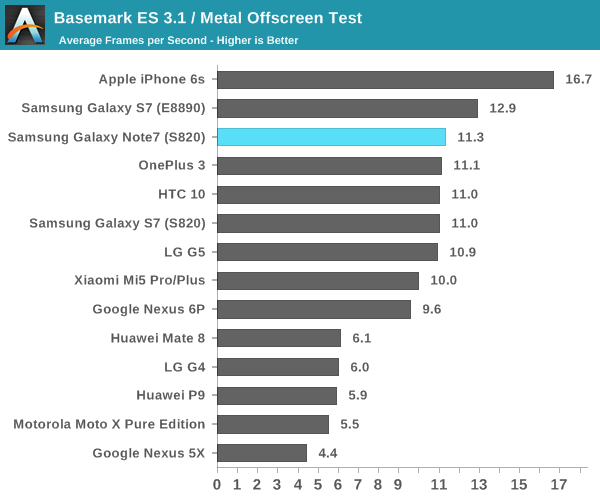
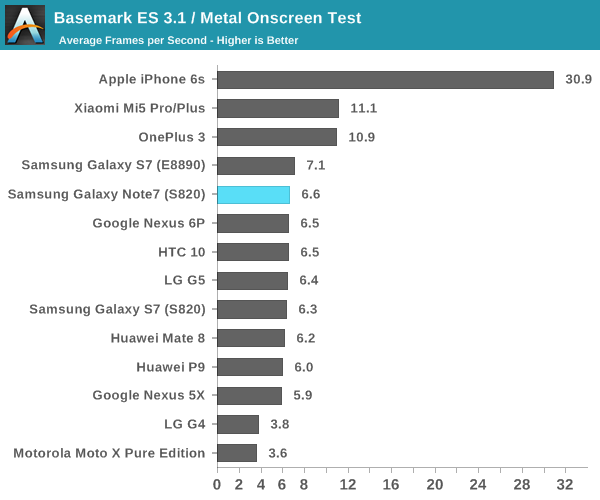
It's probably no surprise, but the Galaxy Note7 performs as expected with the latest drivers and in ideal thermal conditions. The Adreno 530 should be more than sufficient for the forseeable future but for maximum performance it's best to enable 1080p rendering or lower to maximize frame rates in games like Real Racing 3 that tend to really use the GPU to its fullest extent.
NAND Performance
Of course, while Discomark provides a sort of holistic view of performance for a specific task, it’s also important to at least try and break down the various aspects that impact system performance so rather than simple black box testing we can further understand what factors influence performance and therefore provide additional information to make better buying decisions. One of the major contributors to general purpose performance is going to be storage performance, which is often something often ignored by marketing as the nitty gritty details of NAND storage realistically require some background in solid state physics and devices to understand, as well as some understanding of computer science and engineering.
While I’m not really happy with the state of our mobile storage benchmarks, for now I don’t really see another option here as the publicly available storage benchmarks for Android and iOS are fairly basic. Putting aside the state of the benchmarking industry, our current benchmark remains AndroBench 4 which provides at least some basic storage benchmarking capabilities. We use custom settings with this benchmark which attempts to make the test more realistic as the default settings are just wildly unrealistic. This includes adjusting the buffer size, increasing the file size to 100 MB, and only using one thread instead of 8. 256KB file size is targeted as this is the most common block size if you profile this kind of thing for sequential writes and reads, while 4KB block sizes are the most common for other tasks as the vast majority of computer architectures use 4KB pages for virtual memory. Single-threaded I/O is common in most cases because multi-threaded programming is still difficult for most people to reason about in an effective manner because conscious thought is inherently serial in nature with some multiplexing. In addition to this, many eMMC solutions on the market don’t really perform well with multiple threads simultaneously as the controller can’t do anything with extra requests other than reply with a busy signal which already happens with a single thread.
Putting aside discussions of testing we can take a look at the storage solution used in the Galaxy Note7 before getting into the actual results. The Note7 continues to use basically the same storage solution as the Galaxy S7 and S6, which is to say an MLC-based solution that has a UFS Gear 3 single lane interface for bandwidth up to 600 MB/s and basically has the exact same model number if you check the SCSI devices attached to the system save for some changes that indicate the higher 64GB storage relative to the 32GB chips that are most common in the Galaxy S7.
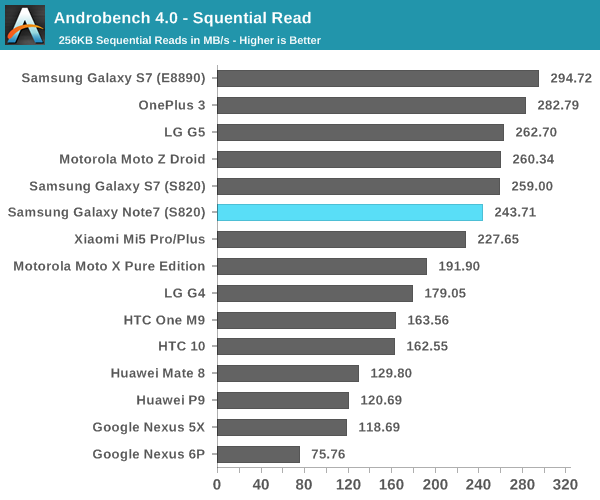

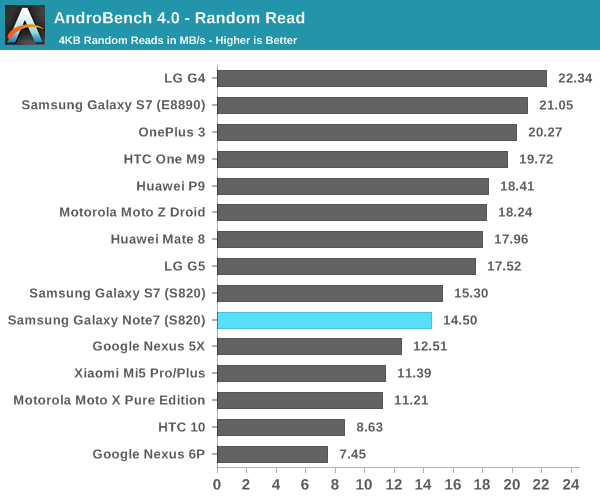
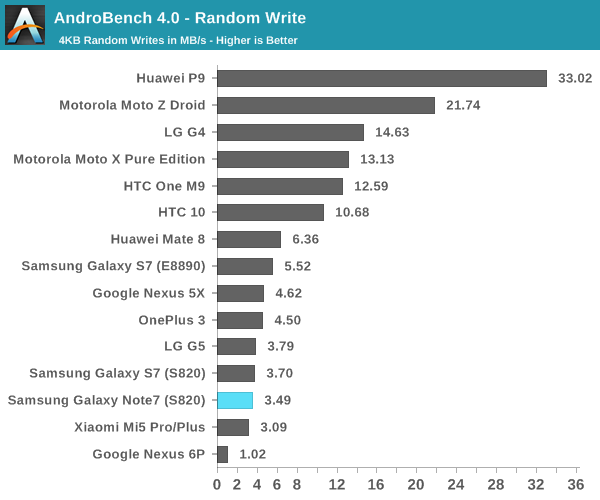
Looking at the test results it performs exactly as quickly as you’d expect from this MLC solution as we’ve tested it in the Galaxy S6, S6 edge, S6 edge+, Note5, S7, S7 edge, and now the Note7 as well as the LG G5. The performance here is acceptable but obviously if you look at burst performance the iPhone 6s has a faster solution due to the hybrid SLC/TLC storage solution. The main benefit of pure MLC NAND is that performance is more consistent as there’s no precipitous drop when the SLC buffer fills. There’s always room to improve but I don’t really see how it’s going to happen unless Samsung moves to V-NAND for the next generation.










202 Comments
View All Comments
theduckofdeath - Tuesday, August 16, 2016 - link
The typical half glass full, negative approach when reviewing Samsung devices at Anandtech... I guess more of you guys wants a job at Apple like the one Anand managed to get?theduckofdeath - Tuesday, August 16, 2016 - link
Half glass empty, that is...See, I'm simply not capable of being as negative as an Anandtech writer. :)
jiffylube1024 - Tuesday, August 16, 2016 - link
I hate to hear the "Anandtech is posting biased reviews" argument because they do such a good job of being in-depth, and I appreciate their reviews tremendously. However, I agree that there is a bias in the wording, intentional or not, against Samsung's recent Galaxy phones, which have been spectacular options in the Galaxy S6/S7 era, even in spite of Touchwiz's shittiness.Is Samsung's aluminum and glass industrial design and unique bezel-free design really so bad? Anandtech thinks it's tired and needs a refresh. In The Verge's review, they come up with a completely different conclusion - they say the Note 7 the best big phone ever, and praise how Samsung has out-designed the competition. Such a huge discrepancy down to essentially a matter of taste. Can we not reach a middle ground - every review of a Galaxy review on AT needs to mention how they need to spice up the "rectangle with rounded corners". It's fine for what it is!
----
To take just one example to hone my point, The iPhone 6S's camera in the AT review was rightly praised for its improved video - 4K recording and 1080p 120 fps. However very little was made of how it was essentially the same damn sensor as the last gen with shrunken pixels giving it a nominal bump from 8MP to 12MP, with basically zero quality difference in stills.
In the Samsung Galaxy S7 review, the super fast laser Autofocus was mentioned, but the overall image quality was described thusly "However, with that said the output of the Galaxy S7 and S7 edge’s camera is not that impressive. I would argue that while it’s not worse than the iPhone 6s Plus, it is basically comparable."
It's not that impressive, yet equal to the iPhone 6S Plus. There was nothing in the iPhone 6S review or conclusion that described its camera as mediocre, yet that's how it comes off in the S7 review - Samsung has to be better, or it's unimpressive.
lilmoe - Tuesday, August 16, 2016 - link
Samsung has to be a lot, LOT, better, or it's unimpressive. FTFY.It's a mentality that really kills me.
theduckofdeath - Wednesday, August 17, 2016 - link
Exactly.Just because a person writes a ten page biased review it really doesn't make it less biased. This place just can't learn from old mistakes. Anandtech used to be a place you could go to to read reliable in-depth reviews about technology and gadgets. I don't know exactly when that changed, but I guess it was a long time ago when Anand had received enough gifts and perks from Apple to sway the whole writing culture on Anandtech.
thunderwave_2 - Thursday, August 18, 2016 - link
Here in the UK, though, they're charging £700 for it. You could buy two OnePlus 3's (£329 each) and still have change. Don't get me wrong, this is surely the better phone. But is it really worth twice the price?lilmoe - Saturday, August 20, 2016 - link
Then why isn't the same being said about every other expensive phone???Meteor2 - Saturday, August 20, 2016 - link
It is.theduckofdeath - Saturday, August 20, 2016 - link
Read the first page of the iPhone 5 SE review and you'll get some perspective. An over-priced cynical release that Apple released thinking consumers were all stupid. Not a single complaint about Apple reusing the exact same hardware of a phone they had released several years earlier, and still asking for a stupid high price.This Galaxy Note 7 is still using a really unique design language that no other brand has managed to copy. Read the first page of this review again.
This site has gone down the drain as an Apple marketing portal. Which I guess is why the comment sections are really starting to die. Because you know, people are not as stupid as Apple and Anand and his minions seem to think.
Bluetooth - Tuesday, August 16, 2016 - link
How can you say that when they do absolutely the best reviews, which are based on actual and realistic measurements. If you prefer superfluous reviews go to The Verge.